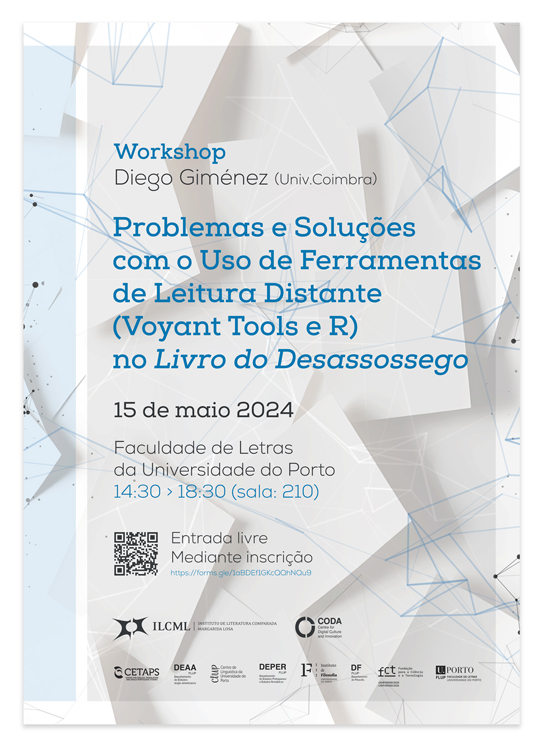Problems and Solutions with the Use of Distant Reading Tools (Voyant Tools and R) in the Book of Disquiet
Diego Giménez
Admission free upon registration: https://forms.gle/1aBDEf1GKcQQhNQu9
Seminar: 3-5 hours
Abstract: The course “Problems and Solutions with the Use of Distant Reading Tools (Voyant Tools and R) in the Book of Disquiet” has a practical dimension and aims to work with textual analysis tools for the study of literary / philosophical works. The workshop stems from research into the philosophical relations of Fernando Pessoa’s work, where intertextuality, taxonomies and post-textuality are studied in the writer’s text. The aim is to present the problems and solutions found in analysing and reading Bernardo Soares’ work from a distance.
This module is designed as an introduction to some of the functionalities of the Voyant-Tools (https://voyant-tools.org/) and Quanteda tools. Visualisation as a computer representation strategy is based on the metaphorical translation between a set of quantitative data and a set of graphic elements. The graphic elements establish a system of relationships with each other, the aim of which is to abstract and simplify a system of quantitative relationships.
Keywords: Digital Humanities, Book of Disquiet, Distant Reading, Quantitative Data Interpretation, Voyant-Tools, Quanteda.
Program:
1. Introduction to LdoD.
2. Introduction to textual analysis tools, with a focus on Voyant Tools.
3. Practical demonstration of the use of Voyant Tools to analyse literary texts.
4. Practical execercise: students explore The Book of Disquiet using Voyant Tools for textual analysis.
5. Examples of analysis with R.
6. Interpreting quantitative data: Close Reading and Distant Reading
7. Discussion and Questions
8. Conclusion
Pedagogical objectives
The objectives of the course include familiarising students with the concepts and examples of projects related to Digital Humanities, exploring the intersection between digital technology and the humanities, introducing students to textual analysis tools, with a focus on Voyant Tools, and enabling them to practise analysing literary texts using these tools; and allowing the students to be able to interpret quantitative data, in the context of the interaction between Close Reading and Distant Reading, and encouraging them to understand the results obtained through quantitative techniques critically.
Works cited
Drucker, J. (2020). Visualization and Interpretation. The MIT Press.
Giménez, D., & Gomide, A. (2022). Pesquisa Literária com R. Revista Estudos do Século XX, 135-153. doi:10.14195/1647-8622_22_7
Moretti, F. (2005). Graphs, Maps, Trees: Abstract Models for Literary History. Verso Books.
Pessoa, F. (2012). Livro do Desassossego. Ed. Zenith, R. Assírio & Alvim.
Piper, A. (2018). Enumerations: Data and Literary Study. The University of Chicago Press.
Portela, M., & Silva, A. R. (2017). Arquivo LdoD: Arquivo Digital Colaborativo do Livro do Desassossego. Centro de Literatura Portuguesa da Universidade de Coimbra. URL: https://ldod.uc.pt/.
Santos, D., Alves, D., Amaro, R., Araújo Branco, I., Fialho, O., Freitas, C., Higuchi, S., Langfeldt, M., Marques Lopes, J., Luís dos Santos, A., Pires, E., Ramos, B., Sanches, D., Schumacher Fuão, R., Silva Pereira, P., & Terra, P. (2020). Leitura distante em português: resumo do Primeiro Encontro. MATLIT: Materialidades Da Literatura, 8(1), 279-298. https://doi.org/10.14195/2182-8830_8-1_16.
Underwood, T. (2019). Distant Horizons: Digital Evidence and Literary Change. The University of Chicago Press.


